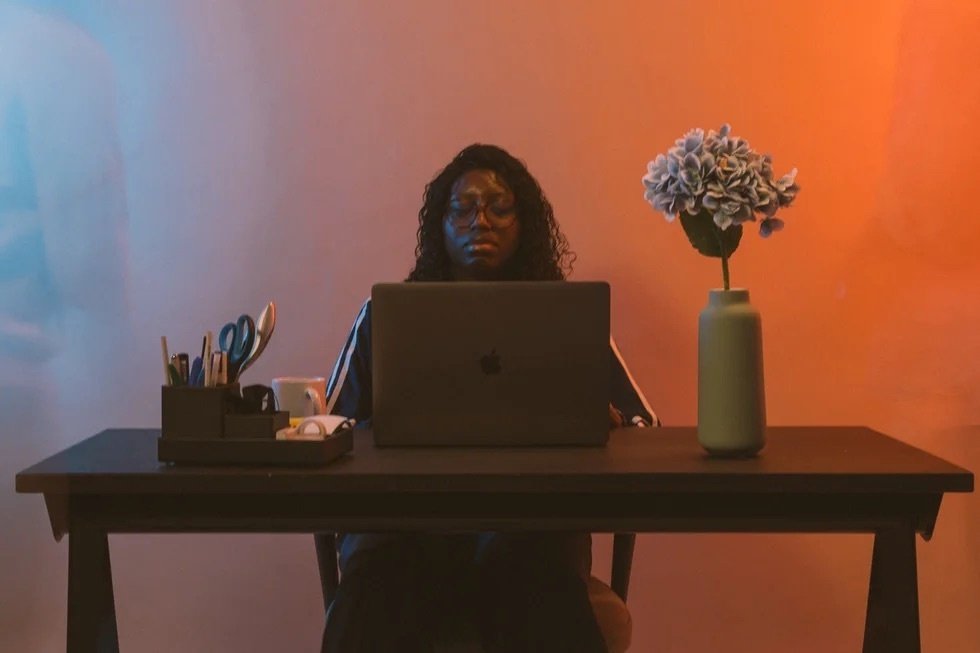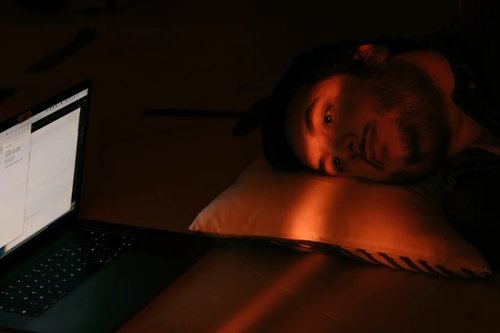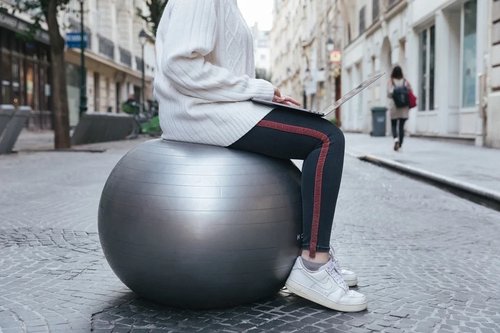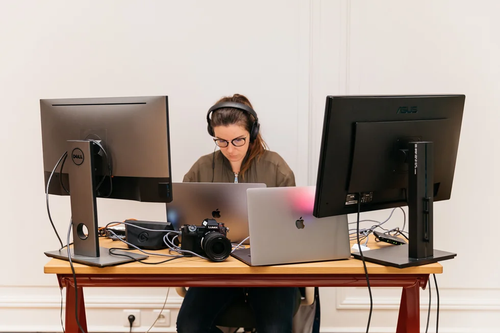Glued to your desk all day? Try these discreet exercises
18 oct. 2023
7min


US Editor at Welcome to the Jungle
The shift to remote working is posing unique challenges to our health. Stanford University’s Center on Longevity studied the impact of working from home (WFH) on our sitting and exercise habits. The findings? Americans are sitting more and moving less. Between 2007 and 2016, the amount of time Americans spent sitting every day increased from 5.5 to 6.4 hours. The pandemic only made things worse, with lockdowns adding about two hours more of inactivity each day. And while WFH brings benefits, such as reduced stress and increased flexibility, it also means that many of us are spending a lot more time sitting down.
This poses significant risks as prolonged inactivity is harmful to health. “Being sedentary… can lead to a host of health issues – think obesity, cardiovascular disease, and musculoskeletal problems,” explains Michael Jones, an ergonomist and author of Stand Up! Upgrade Your Posture and Upgrade Your Life. Jones, who is dedicated to helping remote workers eliminate back pain and be more productive, says that adding movement to our workday is essential to counteract the dangers of being sedentary. “Sitting reduces blood flow, resulting in muscle stiffness and strain,” he says.
While walking meetings are one way to keep active, they aren’t always feasible. So how can we stay active when we have to stay glued to our desks during Zoom calls or when doing very involved work? One solution is to do some desk exercises. The right stretches can offset the negatives of sitting for too long. So, we asked Jones to share some easy desk moves that can boost our work wellness.
Rethinking exercise in the post-Covid era
Many envision exercise as involving weights, mats, and a dedicated space. However, Jones provides a different perspective for those back in the office post-Covid. “It’s not about launching into an intense workout,” he says. “The goal is to break the prolonged periods of immobility when stuck on our screens.”
Jones champions the idea of taking regular “posture breaks.” These exercises don’t have to be dramatic jumping jacks that grab everyone’s attention. Think wrist and ankle rotations, neck tilts, and back stretches, which are low-key but effective in promoting overall health. For beginners, the approach is simple. “Take a minute every hour. Stretch, touch your toes, or lift your knees. The idea is to keep moving and prevent stiffness,” he says.
Far from being interruptions, these brief exercise breaks can be catalysts for productivity. “Stepping away [from your desk] for a few minutes can refresh your focus and energy,” says Jones. “If you’re grappling with a problem, this short reprieve can often illuminate the solution.” These ‘disruptions’ could be the key to feeling more at ease and being more effective.
A guide to office mobility: Top stretches for workspace wellness
Which exercises you can do to combat your sedentary life will depend on your situation, explains Jones. If you are joining a meeting online, there are subtle, nearly invisible exercises that you can do. On the other hand, there are also more active routines for the moments when you have a tad more freedom.
So why not explore these exercises, which are tailored for both the “on-camera” and “off-camera” times of your day, and ensure that no matter the situation, movement remains a constant? Just make sure to check with your healthcare practitioner before engaging in any exercises if you have any health concerns or injuries.
Sneak-ercises: Stretches for on-screen
You’re deep into your fourth consecutive hour of video meetings and your body craves movement, but standing up or being overtly active could be disruptive. So, what’s the workaround? “It’s simpler than you might think,” Jones says. “Consider wrist and ankle rotations or gentle neck tilts.” These exercises can be so discreet that no one would even notice. Your ankles can rotate under the table, wrists flexed off-screen, and a slight neck tilt can seem like nothing more than a natural gesture.
Jones has observed a phenomenon in offices: “When one person starts these exercises, it’s not uncommon to see others join in. It’s like being reminded of the need to move.” So movement can spread, and as can the health benefits.
Off-camera exercises
Whether working from a home office or having some space at your office, these exercises can keep you moving.
Toe touches
These stretches release tension and promote flexibility in the hamstrings, calves, and lower back. “Even if you can’t quite reach your toes, the act of reaching can provide that essential stretch,” explains Jones.
Here’s how to do it:
- Sit at the edge of your chair.
- Extend your legs forward.
- Lean forward from your waist and keep your back straight, reaching your arms towards your feet.
Neck stretches
While doing this exercise, you should “feel a good stretch in the shoulders and the side of your neck,” Jones says. It’s a refreshing break from the usual forward gaze. Jones shows you the neck stretch from his YouTube channel, or follow these instructions:
- Grab the bottom of the chair for stabilization.
- Turn your head slowly to the right and then to the left.
- Now, stretch your neck first on one side, then on the other, always moving slowly and gently.
Chair twists
It’s always important to maintain flexibility in our torsos. “Twisting in your chair and looking behind you is crucial, so you don’t lose that range of motion,” Jones explains, “because that’s the first thing to go.”
This exercise is done as follows:
- Sit up straight in your chair.
- Place one hand on the opposite knee and the other on the chair’s backrest.
- Gently twist your torso towards the backrest, turning your head in the same direction. Then repeat on the other side.
Chest expansions
“Our chest muscles often tighten from hunching,” Jones says. His solution? Desk chest openers. Watch Jones performing the exercise or follow these instructions:
- Put your hands in a fist and put one fist on each side of your head
- Bring your elbows together in front of your face
- Then, open your elbows as wide as possible, bringing your shoulder blades together.
- Repeat.
Chair squats
These are popular in many offices, Jones says. This discreet exercise not only works on your thighs and glutes but also helps in building strength and endurance for prolonged periods of sitting. Here’s how to do the chair squat effectively:
- Stand upright with feet shoulder-width apart, facing away from your chair.
- The goal is to lower your body until you hover over the chair, not fully sitting.
- Begin to squat down, pushing your hips back and bending your knees. Keep your chest up and spine neutral. Briefly pause when you’re almost touching the chair.
- Then, push through your heels to return to the starting position.
Side body desk stretch
“This stretch can awaken those side muscles, which often get ignored,” Jones says.
See how Jones does it or follow these steps:
- While sitting at your desk, reach your hand to your opposite hip
- Bring the other hand up by your side and over your head, stretching to the side while looking up at the ceiling.
- Repeat on the other side.
Hands-above-head stretch
“Just by extending your arms above your head, you’re promoting circulation and countering the negative effects of prolonged sitting,” Jones says. This easy movement can assist in correcting posture and alleviating tension in the shoulders. Here’s how to get the most out of this stretch:
- Sit or stand upright.
- Slowly raise both arms above your head, keeping them straight. Interlock your fingers and turn your palms facing the ceiling.
- Hold the position for a few seconds, taking deep breaths in and out. Feel the stretch along your arms, sides, and spine.
Cat/cow desk stretch
Jones concludes with an exercise to promote spinal flexibility by making like a cat or a cow. Just a few reps can alleviate that midday stiffness. Here’s how to do it:
- Begin sitting in your chair with your hands flat on the desk and reaching out in front of you.
- Round your back, tucking your chin inwards. This is the cat.
- Now, move through so you look up and your back is arched. Here’s the cow.
- Hold each pose and repeat while maintaining breathing.
Just move
When asked for more exercises, Jones replied, “Just please do something.” Walking up and down the hallway or a quick jaunt up a flight of stairs adds even more benefits. “It’s just so refreshing… to get that blood flow going,” he says. He recommends that individuals stand and move every 1 to 2 hours. “It is definitely not going to make or break your workday.” And hey, maybe jumping jacks next to your desk isn’t such a bad idea after all.
Additional tips on staying active at your desk
1. Equipment to keep nearby
Jones recommends keeping this equipment within arm’s reach for those much-needed breaks.
- Resistance bands: These stretchable bands are Jones’s favorite. “[They] bring blood flow straight to the body,” helping muscles to grow and repair. They are helpful for doing simple exercises such as bicep curls right at your desk.
- Posture cushions: This equipment encourages “active sitting,” allowing movement from side to side. Jones points out that they help engage the core, preventing the dreaded “postural collapse” from prolonged sitting.
- Tennis ball: Particularly useful for those with shoulder blade pain. Place it between the shoulder blades and lean against a wall for a relieving massage.
- Exercise ball (Swiss ball): These versatile balls can replace a chair, engaging the core and improving posture. Jones says, “Our core becomes so weak from sitting and slumping over,” and these balls counteract that.
- Weights or water bottles: Simple weights or even filled water bottles can be a tool for light arm exercises during short breaks.
2. Schedule exercise breaks
Jones recommends that employees approach management to incorporate short exercise “breaks” amidst a busy meeting schedule. He suggests backing this approach with research, underlining that an employee’s health and happiness directly impact their output. By framing the request with evidence, employees can highlight the tangible benefits for both the individual and the company.
3. But please, no back braces
Jones strongly advises against using back braces unless advised to do so by a medical practitioner. He believes they can weaken the muscles and even cause sensations such as numbness in the fingertips. Instead of relying on such devices, he emphasizes the importance of exercise.
The concerning rise in sedentary behavior – particularly since the pandemic and subsequent increase in remote working – highlights the need to be proactive. So, the next time you find yourself fixed to your desk, remember: movement is not just an option but a necessary ingredient for a healthy, productive work life.
Photo: Welcome to the Jungle
Follow Welcome to the Jungle on Facebook, LinkedIn, and Instagram to get our latest articles every day, and don’t forget to subscribe to our newsletter!

Inspirez-vous davantage sur : Santé

Navigating your career while managing chronic illness
Struggling to juggle work and chronic illness? Learn how to create a supportive career path and find solutions.
24 déc. 2024

The best equipment to help you get exercise without leaving your desk
A sedentary lifestyle can lead to serious health problems. So, how can you stay fit while still at your desk?
09 nov. 2023

How the world of work is getting better for veterinarians
Though typically not considered a dangerous profession, veterinary services rank among the highest industries for non-fatal injuries
04 oct. 2023

The dynamic benefits of walking meetings
As our jobs become more flexible, workers are finding new ways to improve their mental and physical health
03 oct. 2023

Digital eye strain: You are not alone
With the average American spending more hours in front of the screen than sleeping, computer vision syndrome has become a folk illness.
04 oct. 2022
La newsletter qui fait le taf
Envie de ne louper aucun de nos articles ? Une fois par semaine, des histoires, des jobs et des conseils dans votre boite mail.

Vous êtes à la recherche d’une nouvelle opportunité ?
Plus de 200 000 candidats ont trouvé un emploi sur Welcome to the Jungle.
Explorer les jobs